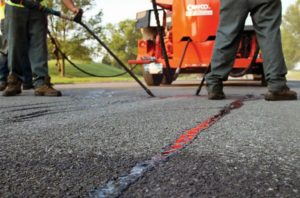Difference between Crack Sealing and Crack Filling: Asphalt is a highly durable material with a high fatigue resistance. An asphalt parking lot can last for decades when laid and maintained correctly. However, regardless of how tough, your asphalt lot will inevitably crack at some point due to heavy vehicle traffic and adverse weather conditions. Crack sealing and crack filling are the most effective crack repair solutions that can extend the life of your asphalt parking lot — but which one should you choose?
When faced with a cracked parking lot, you must consult with your asphalt contractor to determine whether to choose crack sealing or filling. Understanding the difference between the two crack repair solutions allows you to pick the best option for your needs.
Differences Between Crack Sealing and Crack Filling
1. Type of cracks When you hire an asphalt contractor for crack repairs, they will first inspect the type of cracks in your parking lot. This helps them determine the best course of action, which may include the use of a crack filler or crack sealant.
When you hire an asphalt contractor for crack repairs, they will first inspect the type of cracks in your parking lot. This helps them determine the best course of action, which may include the use of a crack filler or crack sealant.
Filling cracks is more effective on non-working cracks that are less than 0.1 inches wide. Non-working cracks have no horizontal or vertical movements because their edges are more closely spaced — examples include block cracks, longitudinal cracks, diagonal cracks, and alligator cracks. Because these types of cracks do not expand, they require a temporary patch, which is best accomplished through the application of crack filler.
Crack sealing prevents cracks in asphalt paving from expanding and contracting. Timing is critical when applying a crack sealant — it should be done immediately upon the appearance of cracks to ensure that the sealant keeps them from growing deeper.
2. Type of material Non-working cracks have a low threshold for flexibility and thus require a non-rubberized repair material. Cutbacks, liquid asphalt, and asphalt emulsions are all examples of crack-filling materials.
Non-working cracks have a low threshold for flexibility and thus require a non-rubberized repair material. Cutbacks, liquid asphalt, and asphalt emulsions are all examples of crack-filling materials.
Active cracks expand and contract with the seasons, necessitating the use of a flexible sealant. Rubberized asphalt, asphalt rubber, self-leveling silicone, and low-modulus rubberized asphalt are commonly used crack sealant materials.
3. CostCrack filling demands a 20-30 times lower initial investment than repaving a neglected asphalt surface. Additionally, it lowers the long-term cost of asphalt maintenance. However, you must continue to treat the cracks regularly in the future.
On the other hand, crack sealing is more expensive but provides a more permanent solution.
4. Durability Asphalt crack filling is ideal for deep, non-working cracks that cannot be bonded with sealing. This method of asphalt restoration remains effective so long as the cracks in the pavement do not expand or contract. Therefore, it is often considered a stopgap solution that lasts only one or two seasons.
Asphalt crack filling is ideal for deep, non-working cracks that cannot be bonded with sealing. This method of asphalt restoration remains effective so long as the cracks in the pavement do not expand or contract. Therefore, it is often considered a stopgap solution that lasts only one or two seasons.
sealing is a more permanent solution that can significantly increase the life of your pavement — often by up to eight years or more.
5. ClimateIt is important to consider the temperature readings with crack filling since the climate has a considerable effect on crack expansion. Ideally, the filling should be performed during mild climates with fewer dramatic temperature variations.
Crack sealing is the only treatment that is successful at fixing active cracks that contract and expand with the seasons. sealing is often the only choice in places where temperatures fluctuate drastically.
Which option is the best?
While the crack filling is considered a temporary solution, it is a good option if your parking lot is non-working or low in activity — this is especially true in climates that generally remain stable throughout the seasons. In this case, simply filling the cracks and keeping an eye on them may be enough. Not to mention, the filling is considerably more affordable than sealing. However, if your budget permits a more permanent solution, crack sealing is almost always the better choice. As previously mentioned, sealants allow for seasonal contraction and expansion of cracks that are, and sealing is sure to last a long time.
When you are well informed about the many merits and limitations of both solutions, you can choose the most suitable one for your current need or situation.
Address
Commonwealth Paving, 136 Outerloop, Louisville, Kentucky 40214
Phone: 502-459-7283, Fax: 502-456-2678
Opening Hours
| Monday | 9:00 AM – 5:00 PM |
| Tuesday | 9:00 AM – 5:00 PM |
| Wednesday | 9:00 AM – 5:00 PM |
| Thursday | 9:00 AM – 5:00 PM |
| Friday | 9:00 AM – 5:00 PM |
| Saturday | Closed |
| Sunday | Closed |







